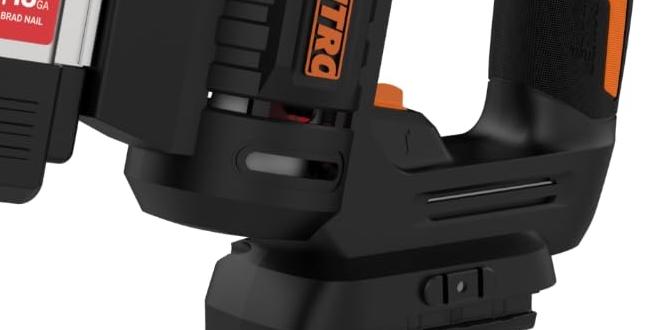Quick Summary: Owning the right nail gun repair tools is crucial for every user to keep their tools running smoothly, prevent costly repairs, and ensure safe operation. Essential tools include cleaning kits, lubricant, O-ring kits, basic screwdrivers, and a specialized nail gun maintenance manual. These items allow for quick fixes and routine maintenance, saving you time and money.
Hey there, fellow makers and DIYers! Jack Shaffer here from Nailerguy. Have you ever been in the middle of a project, your nail gun humming along perfectly, and then suddenly… it sputters? Maybe it jams, or worse, it stops firing altogether? It’s incredibly frustrating, right? It can bring your woodworking dreams to a screeching halt. But what if I told you that a lot of these common nail gun hiccups can be fixed with a few simple tools you can keep right in your workshop or even in your toolbox? You don’t need to be a master mechanic to keep your trusty nail gun in top shape. We’re going to walk through the essential nail gun repair tools that every user should own, making sure you’re always ready to power through your projects with confidence.
We’ll cover everything from the basic cleaning supplies that keep your nailer firing consistently to the small parts that can make a big difference when things go awry. Getting familiar with these tools will not only save you from those dreaded project pauses but also extend the life of your nail gun. Stick around, and let’s get your nail gun running like new, every single time!
Table of Contents
Why Basic Nail Gun Maintenance Matters
Think of your nail gun like any other important tool. If you neglect it, it’s going to give you problems. Regular, simple maintenance is the secret sauce to a long-lasting and reliable nail gun. It’s not about complex overhauls; it’s about preventative care. When you keep your nail gun clean and properly lubricated, you reduce wear and tear on its internal parts. This means fewer jams, more consistent power, and a much safer working experience for you.
The good news is that most maintenance tasks are surprisingly easy and don’t require specialized training. A few common-sense steps and the right tools can prevent many minor issues from becoming major, expensive repairs. Plus, a well-maintained nail gun is a happier nail gun, and that means more productivity for you!
Essential Nail Gun Repair Tools Every User Should Own
Alright, let’s get down to business. What are those must-have items that should be in every DIYer’s or woodworker’s toolkit when it comes to nail gun care? These aren’t exotic, specialized gadgets; they’re practical, accessible tools that will tackle most common issues. Having them on hand means you can perform quick fixes and routine maintenance right when you need it, without having to run to the store or wait for a professional. Let’s break them down:
1. Cleaning & Lubrication Kit
This is the absolute bedrock of nail gun maintenance. A clean nail gun fires better and lasts longer. Dirt, dust, and old lubricant can gum up the works, leading to misfires and jams.
- Nail Gun Cleaner: Look for cleaners specifically designed for nail guns. These are formulated to break down resins, old oil, and debris without damaging the tool’s internal components.
- Lubricant: A few drops of the right lubricant at the right time will keep moving parts (like the piston and driver blade) smooth and prevent friction. Always use the lubricant recommended by your nail gun manufacturer. Using the wrong type can cause damage.
- Lint-Free Cloths or Rags: You’ll need these to wipe down the exterior, clean internal parts, and soak up excess lubricant. Avoid using materials that can leave behind fibers.
- Cotton Swabs or Small Brushes: Perfect for getting into tight spots and cleaning around seals and small components.
2. O-Ring and Seal Replacement Kit
O-rings and seals are the unsung heroes of your pneumatic or electric nail gun. They are crucial for maintaining air pressure (in pneumatic models) and preventing leaks. Over time, these rubber or synthetic parts can dry out, crack, or wear down.
- Universal O-Ring Kits: These kits come with a variety of common O-ring sizes. While it’s always best to get a kit specific to your nail gun model if available, a good universal kit can be a lifesaver.
- Sealant/Grease: When replacing O-rings, a small amount of specialized O-ring grease (often silicone-based) helps them seat properly and prevents premature wear.
3. Basic Screwdriver Set (and Allen Wrenches)
Many nail gun maintenance tasks involve removing access panels, triggers, or other basic components for cleaning or part replacement. A good set of screwdrivers is indispensable.
- Phillips Head Screwdrivers: Essential for many screws found on tool casings.
- Flat Head Screwdrivers: Useful for prying gently (if needed) or for specific types of screws.
- Allen Wrenches (Hex Keys): Some nail guns use Allen screws for assembly or adjustments. A set with various sizes is a good idea.
4. Pliers and Tweezers
Sometimes, small parts are stubborn, or you need to grip something tiny. These tools come in handy during disassembly and reassembly.
- Needle-Nose Pliers: Great for gripping small screws, springs, or O-rings, especially in tight spaces.
- Standard Pliers: Can be useful for holding parts steady.
- Tweezers: For the really minuscule components, tweezers offer precision.
5. Air Duster or Small Air Compressor (for Pneumatic Guns)
If you have a pneumatic nail gun, you’ll be interacting with compressed air. Blow-out dust and debris from the air inlet and other ports can be very effective.
- Canned Air Duster: A convenient option for quick clean-ups of dust and loose debris, especially around the air intake.
- Small Air Compressor with Blow Gun Attachment: If you already have an air compressor for other tasks, a blow gun attachment is fantastic for thoroughly clearing out ports and internal pathways without physically touching sensitive parts.
6. Specialized Manual or Manufacturer’s Guide
While the tools above are general, understanding your specific nail gun is paramount. The manufacturer’s manual is your best friend.
- User Manual: This usually contains information on basic maintenance, troubleshooting common issues, and recommended lubricants and parts.
- Service Manual (if available): For more in-depth repairs, a service manual provides exploded diagrams and detailed instructions. Many manufacturers offer these for download on their websites.
7. Safety Glasses and Gloves
This isn’t a “repair tool” in the mechanical sense, but it’s absolutely essential for your safety during any maintenance or repair work. You’re dealing with springs, small parts, and potential residual air pressure.
- Safety Glasses: Protect your eyes from springs, debris, or cleaning solutions.
- Work Gloves: Protect your hands from sharp edges, grease, and grime.
Performing Basic Nail Gun Maintenance: A Step-by-Step Approach
Now that you know what tools you need, let’s talk about how to use them. Most maintenance tasks are straightforward and follow a similar pattern. Remember, always disconnect the power source (unplug electric models or disconnect the air hose from pneumatic models) before starting any work.
Step 1: Disconnect Power and Inspect
This is the golden rule of tool safety. For pneumatic nail guns, disconnect the air hose. For cordless battery-powered ones, remove the battery. For corded electric ones, unplug them from the wall. Then, take a good look at your nail gun. Is it visibly dirty? Are there any obvious signs of damage?
Step 2: Clean the Exterior
Use a lint-free cloth to wipe down the outside of the tool. This removes surface dust and grime. For tougher spots, you can use a slightly damp cloth, but be careful not to let water seep into any openings.
Step 3: Clean the Magazine and Feed Mechanism
The magazine is where the nails are housed. Dust and debris here can cause feeding issues. Use a brush or cotton swab to clean out the nail channel. Make sure no old nail fragments or debris are left behind. Some nail guns have removable magazines that are easier to clean.
Step 4: Lubricate the Moving Parts (Pneumatic Guns)
For pneumatic nail guns, this is a crucial step. Locate the air inlet. Add a few drops (usually 3-5) of the manufacturer-recommended lubricant. Once lubricated, reconnect the air hose and fire the gun a few times into scrap material to distribute the lubricant throughout the internal mechanism. Over-lubricating can cause issues, so stick to the recommended amount.
Note: Electric and battery-powered nail guns typically do not require regular lubrication of internal moving parts like pneumatic ones do. Refer to your specific model’s manual for any lubrication recommendations for electric versions.
Step 5: Check and Clean the Driver Blade and Bumper
The driver blade is the part that strikes and drives the nail. The bumper is what it strikes against. These can get dirty or slightly damaged. If accessible without major disassembly, gently clean the driver blade and the area behind it. A soft brush is ideal here. Some models allow for easy access to the driver blade for cleaning and inspection.
Step 6: Inspect Seals and O-Rings (Pneumatic Guns)
If you suspect air leaks or a loss of power (on pneumatic models), it might be time to inspect your O-rings and seals. This often requires some basic disassembly, usually involving removing the handle or specific housing sections. Look for cracked, flattened, or worn-out O-rings. If you find any that are damaged, use your O-ring kit to replace them. Make sure to lubricate the new O-rings before installation.
For detailed instructions on how to access these parts and replace O-rings, always consult your nail gun’s manual. You can often find excellent visual guides or videos online by searching for your specific nail gun model.
Step 7: Clear Jams
Nail jams are common. The first step is always to disconnect the power source. Then, carefully try to remove the jammed nail. Most nail guns have a nose latch or a system to access the clearing area. You might need needle-nose pliers if the nail is stuck firmly. Never force it, as this can bend the driver blade or damage the tool. If a nail is deeply jammed, consult your manual.
When to Seek Professional Help or Replace Parts
While these basic maintenance steps and tools can handle many common issues, there are times when you might need more. If you perform the basic maintenance and the problem persists, or if you notice significant damage, it might be time to either replace specific parts or call in a professional.
Common Signs You Need More Than Basic Tools:
- Persistent Misfires: If your nail gun consistently fails to drive nails even after cleaning and lubrication.
- Air Leaks That Can’t Be Fixed by O-Ring Replacement: Significant leaks from cracked housings or other internal damage.
- Bent or Damaged Driver Blade: If the driver blade is visibly bent, broken, or chipped, it needs to be replaced. This often requires some disassembly.
- Difficulty with Disassembly/Reassembly: If you’re uncomfortable taking apart more complex sections of the nail gun.
- Internal Damage: Dropping the tool or a severe jam can cause internal components to break.
Where to Find Replacement Parts:
Finding the right replacement parts is key. Always start with the manufacturer. Their website or customer service department is the best place to get OEM (Original Equipment Manufacturer) parts. Online tool retailers and specialized fastener suppliers also carry parts, but ensure they are compatible with your specific model.
For example, if you have a common brand like DeWalt, Bostitch, or Paslode, you can often find dedicated parts diagrams and ordering systems directly on their support websites. These resources are invaluable for identifying the exact part number you need. According to the Occupational Safety and Health Administration (OSHA), understanding the operating mechanisms and performing correct maintenance are critical for safe nail gun use.
Nail Gun Repair Tools: A Comparison
Let’s look at how some of these essential items stack up. While some are consumables, others are long-term investments.
| Tool/Item | Primary Use | Lifespan | Typical Cost (Approx.) | Importance for Beginners |
|---|---|---|---|---|
| Cleaning & Lubrication Kit | Routine maintenance, performance enhancement | Consumable (cleaner/lube), lasts many uses | $15 – $40 | Essential |
| O-Ring & Seal Kit | Fixing air leaks, maintaining pressure | One-time use per O-ring, kit lasts years | $10 – $30 | Highly Recommended |
| Screwdriver Set | Disassembly/reassembly, basic repairs | Very Long | $20 – $50 | Essential |
| Pliers & Tweezers | Handling small parts, clearing jams | Very Long | $15 – $40 | Highly Recommended |
| Safety Glasses & Gloves | Personal safety during maintenance | Long (may need replacing if damaged) | $10 – $30 | Absolutely Essential |
| Manufacturer’s Manual | Troubleshooting, repair guidance | Indefinite (as long as you have the tool) | Free (usually) | Essential |
As you can see, the initial investment in these tools is quite small compared to the cost of a new nail gun or professional repair. The time and frustration saved are also significant benefits.
Frequently Asked Questions About Nail Gun Repair Tools
Q1: How often should I lubricate my pneumatic nail gun?
A1: For pneumatic nail guns, add 3-5 drops of the recommended lubricant into the air inlet at the beginning of each day’s use or after extended periods of non-use. Over-lubrication can cause the tool to malfunction, so stick to the recommended amount.
Q2: Can I use household oil to lubricate my nail gun?
A2: No, it’s best to use the specific lubricant recommended by your nail gun’s manufacturer. Household oils or general-purpose lubricants may be too thin, too thick, or contain additives that can damage seals and internal components.
Q3: My nail gun is leaking air. What should I do?
A3: Start by checking the O-rings. Disconnect the air source, and inspect the O-rings around the air inlet, piston housing, and any other accessible seals. If you find any cracks, tears, or flattened rings, it’s time to replace them with a new O-ring from your kit. Lubricating the new O-rings before installation is also important.
Q4: What’s involved in clearing a nail jam?
A4: First, disconnect the air/power. Then, gently try to pull out the jammed nail. Most tools have a nose latch that opens a channel for access. If the nail is stuck, try using needle-nose pliers. Never force it, which can damage the driver blade. If it’s a severe jam, consult your manual. For more on safe nail gun operation, check out resources from the National Institute for Occupational Safety and Health (NIOSH).
Q5: Do electric and battery-powered nail guns need the same maintenance as pneumatic ones?
A5: Electric and battery-powered nail guns generally require less maintenance than pneumatic models. They typically don’t need regular oiling of internal parts in the same way. However, they still benefit from regular cleaning of the exterior, magazine, and driver area. Always refer to your specific model’s manual for exact maintenance instructions.
Q6: Where can I find the right O-rings for my specific nail gun model?
A6: Start by checking your nail gun’s user manual. It often lists part numbers for common wear items like O-rings. Your best bet is to contact the manufacturer directly or visit their official website for replacement parts. Reputable online tool suppliers also carry parts, but make sure you confirm compatibility for your exact model.




